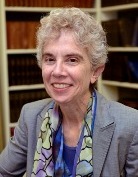Dear New Lawyer – Debra L. Raskin

President’s Column, October 2015
You have been much on our minds at the New York City Bar Association. In recent years, we have offered increased opportunities for you to network, develop your career, position yourself to land a job, hone your skills, participate in committee work, and enjoy yourself with new colleagues and friends.
In 2012, under the leadership of my predecessor Carey Dunne, the City Bar formed the Task Force on New Lawyers in a Changing Profession to find more and better ways to prepare you to thrive in a progressively tougher legal field.
By the way, notice I address you as “new” lawyer, not “young” lawyer. That’s because not all new lawyers are necessarily young.
The report of the Task Force, which was chaired by Mark Morril, included four initiatives, and I am pleased to report on the City Bar’s continuing work on all of them.
The City Bar New Lawyer Institute was created in response to the Task Force’s finding that current legal education models do not necessarily fully prepare new lawyers like you to enter the workforce. The Institute, which runs from August through May, has just kicked off its second year and has quickly become a valuable resource for your peers. Great thanks go to this year’s sponsoring law schools: Brooklyn Law School, Cardozo Law School, Columbia Law School, CUNY School of Law, Fordham Law School, Hofstra Law School, New York Law School, and UConn School of Law.
The Task Force also recommended a review of the New York bar exam to assess whether it was testing your competencies in the right way in an increasingly national and global legal profession. The City Bar’s Council on the Profession undertook that review and, as a result, supported Chief Judge Jonathan Lippman’s proposal to institute the Uniform Bar Exam in New York beginning in July 2016. The Chief Judge included a procedure for evaluating the exam’s impact on different demographic groups, as the Task Force had proposed, to ensure that the UBE does not have a disparate impact on historically disadvantaged individuals.
The Task Force also determined that “bridge-to-practice” programs would provide valuable training and employment opportunities for law students and new lawyers while easing the burden of their law school-related expenses. Accordingly, the City Bar had identified major government and private sector employers willing to participate in such programs where students are given academic credit for full-time work. However, the ABA’s rules currently prohibit law students from receiving both pay and academic credit for externships with for-profit employers. The City Bar is strongly supporting a change in those rules.
Finally, and most ambitiously, the City Bar along with the CUNY School of Law and 19 law firms recently announced the creation of the Court Square Law Project. Set to launch in 2016, the Project will be a law firm for persons of moderate means whose income exceeds legal services guidelines but who plainly cannot afford the services of traditional law firms. The project will be staffed by new lawyers under the supervision of experienced attorneys, enrolling ten new attorney-fellows in two-year fellowships in each of the first four years of the five-year pilot program. Participants will receive a stipend as they get the training and experience they’ll need to transition to a self-sustaining law practice after two years.
I think it’s an inspired response to two current phenomena: A perceived “oversupply” of lawyers who are having difficulty finding work, and the great numbers of middle-class people who can’t pay market legal rates.
Supply, meet demand. According to an ABA survey, nearly two-thirds of American households with legal issues did not seek the assistance of a lawyer. Fully 99% of clients in eviction and consumer credit cases are unrepresented, the City Bar Task Force reported. That shocking underrepresentation persists despite the well-documented disparity of outcomes between litigants who have legal assistance in housing, bankruptcy, immigration, and other such critical matters, and those who do not.
Enter the Court Square Law Project. The initiative, which will be open to graduates of all law schools, will be housed at and benefit from the resources of the new CUNY School of Law campus in Long Island City. For clients who would otherwise have gone without representation, the Court Square Law Project will be a game-changer. And to the extent that the model is seen as an idea whose time has come and is replicated elsewhere, the Project has the potential to be a culture changer as well.
Special thanks go to CUNY School of Law Dean and Professor Michelle Anderson, who chairs the Court Square Law Project Executive Committee, and to Task Force members Bradley Butwin, Chair of O’Melveny & Meyers; Eric J. Friedman, Chair of Skadden Arps Slate Meagher & Flom; and Brad Karp, Chair of Paul Weiss Rifkind Wharton & Garrison, for their leadership in organizing the New York City law firm community to contribute start-up funding for CSLP.
Finally, great thanks to the Founding Sponsor law firms, each of which has pledged an extraordinarily generous $100,000 to launch the Court Square Law Project: Cravath, Swaine & Moore LLP; Davis Polk & Wardwell LLP; Debevoise & Plimpton LLP; Fried, Frank, Harris, Shriver & Jacobson LLP; Gibson, Dunn & Crutcher LLP; Kirkland & Ellis LLP; Kramer Levin Naftalis & Frankel LLP; Latham & Watkins LLP; Morgan, Lewis & Bockius; O’Melveny & Myers LLP; Paul, Weiss, Rifkind, Wharton & Garrison LLP; Proskauer Rose LLP; Schulte Roth & Zabel LLP; Shearman & Sterling LLP; Simpson Thacher & Bartlett LLP; Skadden, Arps, Slate, Meagher & Flom LLP; Wachtell, Lipton, Rosen & Katz LLP, and Weil Gotshal & Manges LLP; and Winston & Strawn LLP.

